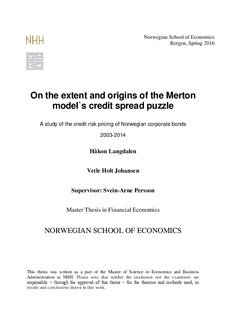On the extent and origins of the Merton model`s credit spread puzzle : a study of the credit risk pricing of Norwegian corporate bonds 2003-2014
Abstract
For decades, financial literature has attempted to understand the pricing of credit risk in
corporate bonds, and the Merton (1974) model is one of the classic approaches to determine a
theoretic size for this credit risk premium. However, empirical studies have shown that the
model`s estimates deviate substantially from observed credit spreads, a phenomenon called
the “credit spread puzzle”. In our thesis, we implement an augmented Merton model from
Feldhütter and Schaefer (2015), and compare the model`s estimates to 13,560 real-life spreads
of Norwegian corporate bonds 2003-2014. On an aggregate level, the model only explains
26% of the median spread to the swap rate, a result consistent with previous Norwegian
studies. A decomposition of the model mispricing discloses several potential explanations for
the credit spread puzzle. Firstly, the model input factors for debt leverage and issuer volatility
are key drivers of the puzzle. The model underestimation is particularly strong for safe bonds
with low leverage or volatility, and we highlight problems of historic volatility measures and
the precautionary motives for holding low leverage as potential explanations for these
patterns. Secondly, sector affiliation correlate with the model mispricing, and when we
control for other factors, we find that investors in the Norwegian corporate bond market
charge an additional premium for companies in the industrial sector compared to others.
Thirdly, despite the importance of bond liquidity and the Fama & French (1993) factors for
size and growth in previous literature, we find that the presence of these factors seems limited
in explaining the credit spread puzzle in our sample. In total, our thesis illustrates the
complexity of credit risk pricing. To a large degree, the valuation of Norwegian corporate
bonds remains an activity for professional investors, whose analysis of the particular issuer
can incorporate a far more detailed level of risk characteristics than what is possible in a
simple credit risk model.
